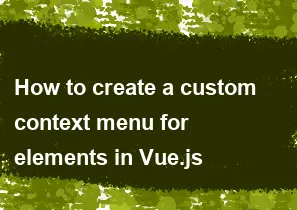How to create a custom context menu for elements in Vue.js

Creating a custom context menu for elements in Vue.js involves a few steps. Below is a basic guide on how to achieve this:
Set up your Vue.js project: Make sure you have a Vue.js project set up. You can do this using Vue CLI or by including Vue.js via CDN in your HTML file.
Create a component for your context menu: This component will represent your custom context menu.
Attach event listeners to trigger the context menu: You'll need to attach event listeners to trigger the display of your custom context menu. Typically, this involves listening for the
contextmenuevent.Position the context menu: You'll need to position the context menu based on the mouse click event.
Here's an example of how you can implement these steps:
html<!-- ContextMenu.vue -->
<template>
<div v-if="visible" class="context-menu" :style="{ top: posY + 'px', left: posX + 'px' }">
<ul>
<li @click="handleItemClick('Option 1')">Option 1</li>
<li @click="handleItemClick('Option 2')">Option 2</li>
<li @click="handleItemClick('Option 3')">Option 3</li>
</ul>
</div>
</template>
<script>
export default {
props: ['posX', 'posY', 'visible'],
methods: {
handleItemClick(option) {
console.log('Selected:', option);
// Here you can emit an event or perform any action based on the selected option
}
}
};
</script>
<style scoped>
.context-menu {
position: fixed;
z-index: 1000;
background-color: white;
border: 1px solid #ccc;
border-radius: 4px;
box-shadow: 0 2px 4px rgba(0, 0, 0, 0.2);
padding: 8px 0;
}
.context-menu ul {
list-style: none;
padding: 0;
margin: 0;
}
.context-menu li {
padding: 8px 16px;
cursor: pointer;
}
.context-menu li:hover {
background-color: #f0f0f0;
}
</style>
In your parent component:
html<template>
<div>
<div
v-for="(item, index) in items"
:key="index"
@contextmenu.prevent="showContextMenu($event, index)"
class="item">
{{ item }}
</div>
<ContextMenu
:posX="contextMenuX"
:posY="contextMenuY"
:visible="contextMenuVisible"
/>
</div>
</template>
<script>
import ContextMenu from './ContextMenu.vue';
export default {
components: {
ContextMenu
},
data() {
return {
items: ['Item 1', 'Item 2', 'Item 3'],
contextMenuX: 0,
contextMenuY: 0,
contextMenuVisible: false
};
},
methods: {
showContextMenu(event, index) {
event.preventDefault();
this.contextMenuX = event.pageX;
this.contextMenuY = event.pageY;
this.contextMenuVisible = true;
}
}
};
</script>
<style scoped>
.item {
padding: 10px;
border: 1px solid #ccc;
margin: 5px;
cursor: pointer;
}
</style>
In this example, we have a parent component that contains some items. We attach a contextmenu event listener to each item and show the custom context menu (ContextMenu component) when the event is triggered. The ContextMenu component displays a list of options and emits an event when an option is clicked.
-
Popular Post
- How to optimize for Google's About This Result feature for local businesses
- How to implement multi-language support in an Express.js application
- How to handle and optimize for changes in mobile search behavior
- How to handle CORS in a Node.js application
- How to use Vue.js with a UI framework (e.g., Vuetify, Element UI)
- How to configure Laravel Telescope for monitoring and profiling API requests
- How to create a command-line tool using the Commander.js library in Node.js
- How to implement code splitting in a React.js application
- How to use the AWS SDK for Node.js to interact with various AWS services
- How to use the Node.js Stream API for efficient data processing
- How to implement a cookie parser middleware in Node.js
- How to implement WebSockets for real-time communication in React
-
Latest Post
- How to implement a dynamic form with dynamic field styling based on user input in Next.js
- How to create a custom hook for handling user interactions with the browser's device motion in Next.js
- How to create a custom hook for handling user interactions with the browser's battery status in Next.js
- How to implement a dynamic form with dynamic field visibility based on user input in Next.js
- How to implement a dynamic form with real-time collaboration features in Next.js
- How to create a custom hook for handling user interactions with the browser's media devices in Next.js
- How to use the useSWRInfinite hook for paginating data with a custom loading indicator in Next.js
- How to create a custom hook for handling user interactions with the browser's network status in Next.js
- How to create a custom hook for handling user interactions with the browser's location in Next.js
- How to implement a dynamic form with multi-language support in Next.js
- How to create a custom hook for handling user interactions with the browser's ambient light sensor in Next.js
- How to use the useHover hook for creating interactive image zoom effects in Next.js